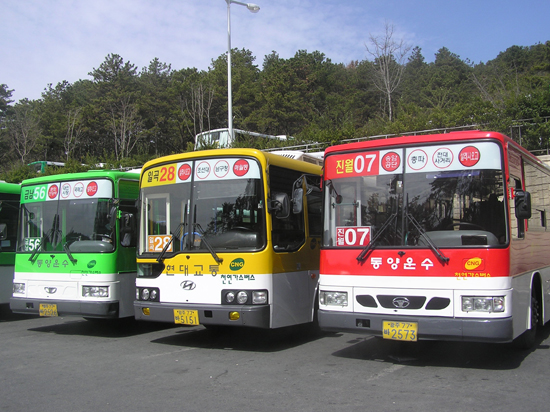<#275 Local Focus>

In the case of the new bus routes, however, citizen’s responses were not as positive as they might have been expected. Previously citizens had to change buses many times to go to any out- of -the-way place because buses mainly serviced the established areas.
Many citizens complained about these difficulties in transfers and protested that this system had to be changed. However, as the new system was introduced at the same time as reorganizing the bus routes, an amount of confusion has resulted.
Many people still have misunderstandings about the new system. Chonnam Tribune examined the new bus system and checked whether it is better for Gwangju and its citizens.
What is the semi-public bus system? It means that private CEOs manage bus companies in cooperation with the city government. To put it concretely, each bus company formerly had exclusive rights to run their buses only to maximize profits, but now their business activities are supervised and they must operate along routes and at intervals as designated by the local authority.
Before setting of the semi-public system, most of the private bus companies were in financial difficulty. The rate of car ownership has drastically increased since 1986, so the number of bus users has been in decline.
As a result bus services were rarely upgraded. With the majority of bus companies facing bankruptcy the city government decided to set up semi-public bus operation and support the companies overcome their losses to some degree.
After the bus lines were changed with the introduction of this new system, passengers are able to use a transit system on all public transportation and any number of transits is possible in an hour due to an electronic card system that makes fare payment easier while allowing operators to increase revenue through distance-based fares.
Besides, BMS (Bus Management System) established on-line monitoring of location and estimated time of arrival for each bus, making it possible for the bus companies to control operation intervals and to accurately predict arrival times and time to destination.

These improvements, however, did not satisfy citizens’ transfer complaints due to the development of new routes. Why has the city office changed routes, central to the functioning of Gwangju as a city? Gwangju has newly developed regions, many of which had insufficient public transport and many residents found it difficult to travel.
The city office, therefore, determined to supply them with buses. “There were two solutions to try and solve the problem. One was to increase bus supply and the other was to convert the routes of already existing buses. As the former involved a lot of costs, about 140 million won to offer 150~180 buses, we couldn’t afford it and so didn’t adopt it. Consequently, we decided to reorganize the bus routes” said the chief officer of Public Transportation Division.
As a result, they organized three kinds of buses, red, green and yellow, to improve things. Red buses go to certain principal places and their aim is fast operation: on green ones citizens can transfer to the subway and other buses: and, yellow buses service residential areas and connect them to downtown and central regions.
Under the new system, most bus drivers’ work conditions have improved, as should their attitude, as the city office has educated them on how to be friendlier toward passengers. A system of evaluating their behavior has also been introduced.
When the new routes started, at first, the bus user-rate fell by about 20% as did bus company income. In addition, many people complained about the inconvenience of the new system. However, after improvement of the routes on Feb 8th, dissatisfaction has decreased more and more and lost income has been recovered. In fact, bus-fare revenue has now increased by 20 million won a day.
Although traffic has greatly improved, some problems still exist. After implementing the new system, bus operation time was extended by three to five minutes, but this is too tight for bus drivers to take a rest. For this reason, reckless driving still often occurs and nothing has improved. As mentioned above bus drivers are now evaluated, with incentives given to the friendliest company.
The incentives, however, are offered only to executives not to the drivers themselves. Subsequently, this system will improve nothing. In fact, the new system doesn’t give the drivers any real benefits so problems will continue to occur without resolution.
For a better traffic system and quality of bus service, the city government should keep their ears open to citizens and try to offer incentives to bus drivers. Moreover, bus companies should improve their drivers’ working conditions and manage their business efficiently.
Smooth traffic flow is not only a matter for city hall or the bus companies. Citizens have their role to play, too. They should not just blame the new system but try to improve traffic in cooperation with it. For example, we should not park our cars unlawfully because often this prevents buses from running on time.
If the city office, the bus companies and their drivers, plus car-drivers make an effort together, we may be able to take a positive step toward better traffic.
이한나 기자
_poesie_@hanmail.net

